10 Tips for Providing Great Customer Service (2024)
- Updated: January 16, 2024


Nearly two-thirds of customers have reported experiencing customer rage from a customer service or support interaction. Yep, the reputation of many companies’ customer service is so bad that the resulting emotion has been given its own name.
Symptoms of “customer rage” usually include increased blood pressure, reddening face, rising voice, and colorful language. This condition is often triggered by being put on hold for an extensive length of time, having your call transferred to another department after a long wait, or talking to customer service reps reading from unhelpful scripts.
The problem is, these companies just aren’t meeting customers’ expectations. In fact, corporate America is risking a loss of $494 billion in revenue by doing things the wrong way when it comes to customer care.
In 2024 and beyond, businesses that prioritize providing great customer service will stand out in their marketplace, have greater customer and brand loyalty, and generate more sales.
10 best ways to provide a great customer service experience in 2024
- Be responsive
- Launch an omnichannel customer service strategy
- Train staff to understand your products and services
- Collect customer feedback
- Invest in self-service tools
- Reward customer loyalty
- Personalize the customer experience
- Equip your team with tools and software to help them work more efficiently
- Be transparent with customers
- Use AI to automate tasks
What Is Good Customer Service?
Good customer service means providing the best quality of customer care possible to provide a frictionless customer experience. This means following customer service best practices, providing helpful resources, solving customer issues in the channels they prefer, and more. In general, this means going to the extra mile – no matter the issue – to exceed your customers’ expectations.
Benefits of Great Customer Service
Great customer service means meeting and exceeding your customer expectations throughout their entire purchasing process and customer lifecycle. From pre-purchase all the way to post-purchase, you want to ensure your customers’ needs are taken care of in a way that creates a healthy relationship and builds trust with your company.
When you take the time to learn your customer’s needs, you can provide them with the best customer service. Businesses will reap the rewards of having great customer service too, with higher customer retention, lifetime customer value, revenue growth, and brand reputation.
1. Reduces customer churn
According to a report from Oracle, 89% of consumers switched to a competitor brand after one negative customer experience.
If you’re providing a more positive experience than your competitors, your customers will feel welcomed and valued. They’ll be more likely to stick around, and you’ll reduce churn. It’s really that simple.
2. Increases customer lifetime value (LTV)
Better customer service also results in a higher customer lifetime value (LTV), the amount of money you expect customers to spend throughout their relationship with your business. The more engaged and satisfied your customers are, the higher the LTV will be, which leads to more sales.
In fact, “highly engaged customers buy 90% more frequently, spend 60% more per transaction, and have 3 times the annual value compared to other customers.” This also leads to upsell opportunities for B2B companies when it comes time for contract and subscription renewals.
3. Drives revenue growth
Happy customers buy more. Businesses that focus on improving their customer experience see an average increase of 80% in revenue. Therefore, the better your customer service, the more likely your company will grow.
4. Improves brand reputation & word of mouth
Consistently delivering exceptional customer service will give your brand an excellent reputation in the marketplace and attract new customers. Before a potential customer makes a purchase, they will consider or research what others have experienced with your brand.
Customers will use search engines to find past customer experiences with your brand on:
- B2B online review sites such as G2, Capterra, TrustRadius, and more
- B2C online review sites such as Angie’s List, Yelp, ConsumerReports, Amazon, Google Reviews, and more.
- Threads on forum sites such as Reddit and Quora
- Recommendations from their networks on Facebook, Twitter, and LinkedIn
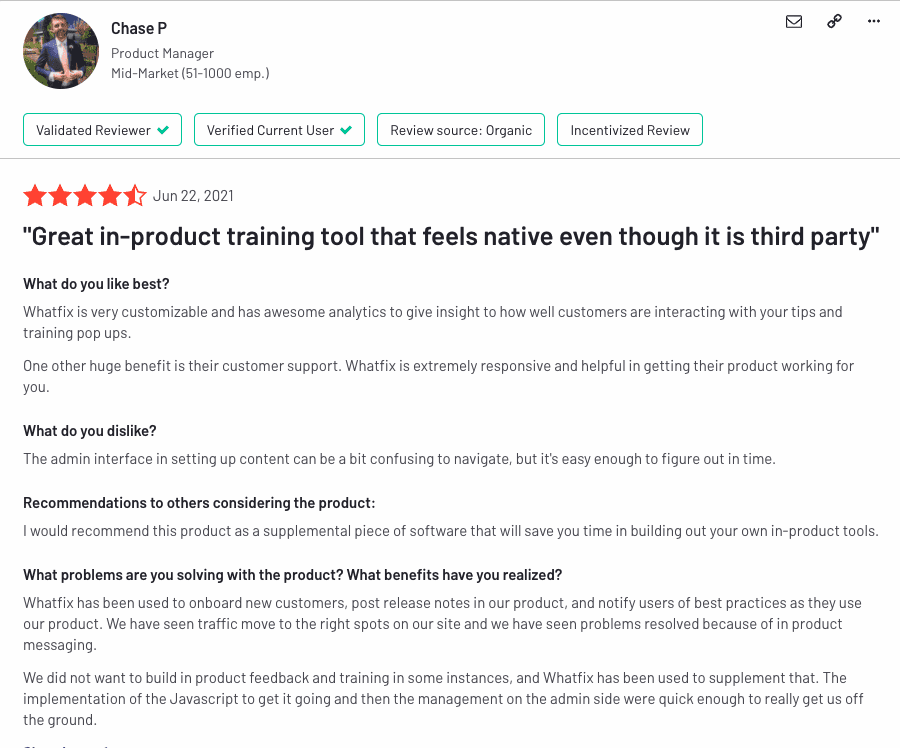
Above: A Whatfix review on G2.com that explicitly mentions our great customer support team (braggy, we know.)
For example, 89% of people read online business reviews before they make a purchase, and 56% of customers would recommend a brand with excellent customer service to family and friends.
For companies with excellent customer service, this becomes a huge driver of new customers and growth – and is equally detrimental to companies with poor customer support.
Principles Of Good Customer Service
To deliver excellent customer service, you first need to understand the principles of good customer service. These principles can guide your team and business through the various scenarios and situations that arise throughout the day to ensure you always deliver a positive customer experience.
Here are the guiding principles of good customer service:
- Understand your customers: to deliver good customer service, you must first gain a deep understanding of your customers. Continuously talk to your customers about their pain points, experiences, and expectations to learn how you can ensure they have positive interactions with your brand.
- Build customer relationships: good customer service starts with building a relationship. Greet your customers as they enter your store, find common interests as you talk to them, and don’t be overly aggressive in assisting them.
- Invest in proper employee training: to provide good customer service, you must train employees to deliver good customer service. Train your employees in three key areas – company culture, product knowledge, and complaint handling – to empower them to deliver high-quality customer service.
10 Tips to Consistently Deliver Great Customer Service
Most companies imagine great customer service including chirpy communication and providing “service with a smile.” But there’s much, much more to it than that – especially for B2B companies, enterprise offerings, SaaS platforms, and consumer products and services that have a high price tag.
If you want to take your customer service from mediocre to great, here are ten tips to help get you pointed in the right direction:
1. Be responsive
Timely responses are essential to a great customer service experience, and in our smartphone era, consumers expect an immediate response. For example, 71% of people under 25 believe that a quick response time is key to a great experience.
The speed of response depends on your support channel(s): 51% “expect a response in less than five minutes on the phone,” and 28% “expect the same on live chat,” while 46% expect companies to respond to emails within 4 hours.
A quick response makes customers feel that their needs and concerns are appreciated, which can help create loyal customers and improve your brand reputation.
For example, Warby Parker, the online prescription glasses and sunglasses retailer, has an excellent customer service reputation. On social media, customers frequently rave about the brand’s quick responses to customer queries.
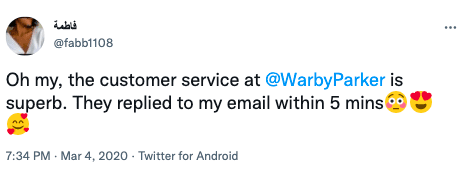
When you make an effort to respond promptly to customers, they will make an effort to offer praise to their network, which increases the reputation of your business and attracts new customers.
And while you might not always be able to address specific customer issues immediately, you can acknowledge their concerns and let them know you are working on a solution, for example, by using an automated email response or by responding on social media.
2. Launch an omnichannel customer service strategy
An omnichannel customer service experience is a coordinated journey that stretches across multiple channels such as email, phone, live chat, social media, in-app chat, chatbots, and other channels where your customers may come for customer service issues.
It’s a critical element of good customer service to provide multiple types of customer support, as you can create a personalized, seamless experience that caters to all your customer’s specific needs, interests, and preferences even when they reach out to you on different channels.
To be considered an omnichannel experience, companies must integrate their channels so customers can bounce between channels without having to start over – ie. your company understands that if someone raises a customer service issue on Facebook Messager, it will be integrated into your support system which can update the customer via email or text.
With an omnichannel experience, companies can resolve issues faster because they know who they’re interacting with and what information they have already shared.
Amazon uses its Amazon Help Twitter account to respond to customers who tweet about issues with an order.
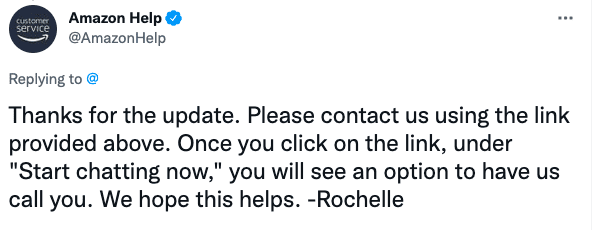
The customer is given a link to Amazon’s support page, where they are able to resolve their issue after chatting with an online agent.
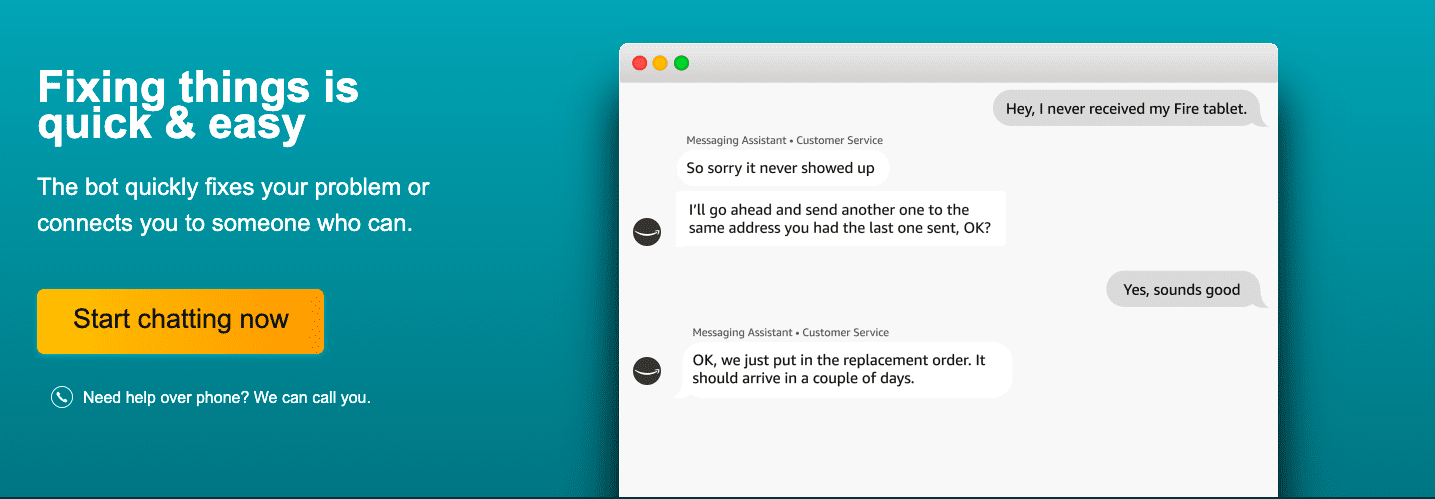
The whole process takes place swiftly and seamlessly across two channels without a hitch.
3. Train staff to understand your products and services
A reported 46% of people say an unknowledgeable representative will cause them to leave a brand. Therefore, to be efficient in their roles, your customer service team needs to have intimate product knowledge so that they can help customers with any issues or questions quickly and easily.
With proper customer service training programs, your team has an in-depth understanding of your goods or services. Be sure to create a customer service training manual that covers how to address and resolve common customer problems.
Chick-fil-A’s employee training is thorough, customizable, and designed around improving the customer service skills of its employees. The fast-food chain has restaurant simulators where employees are trained on minute details of the restaurant — from the wording on menu boards and the placement of condiments to the workflow at the drive-thru and counter.
4. Collect customer feedback
Asking your customers for feedback shows them you care about their opinions. It also allows you to uncover new opportunities to enhance your products or improve the customer service experience.
Several ways to gather customer feedback include:
- Placing a feedback form on your website for customers to share their opinions about your service.
- Deploying in-app messaging for instant feedback from your customers while they use your app.
- Checking social media for company mentions, comments, and reviews.
- Analyzing support tickets to find frequently occurring queries or phrases.
- Creating surveys using tools such as Google Forms or SurveyMonkey to gauge customer satisfaction and sending via email or social media.
To entice customers to share feedback on its service, Epidemic Sound, a global music tech company, emailed a survey to its customers along with an offer for a free six-month subscription to its personal plan.

5. Invest in self-service tools
Customer self-service empowers customers to resolve their own problems without interacting with a company representative. In fact, 81% of customers attempt to troubleshoot before reaching out to a live representative, and 67% of customers prefer to use self-service over speaking to a representative.
Creating an FAQ page or knowledge base are both great strategies to support customers without needing to contact your support team.
For example, see how our customer care team has created a customer knowledge base that empowers customers to search for answers to their questions and support issues without needing to contact our team.
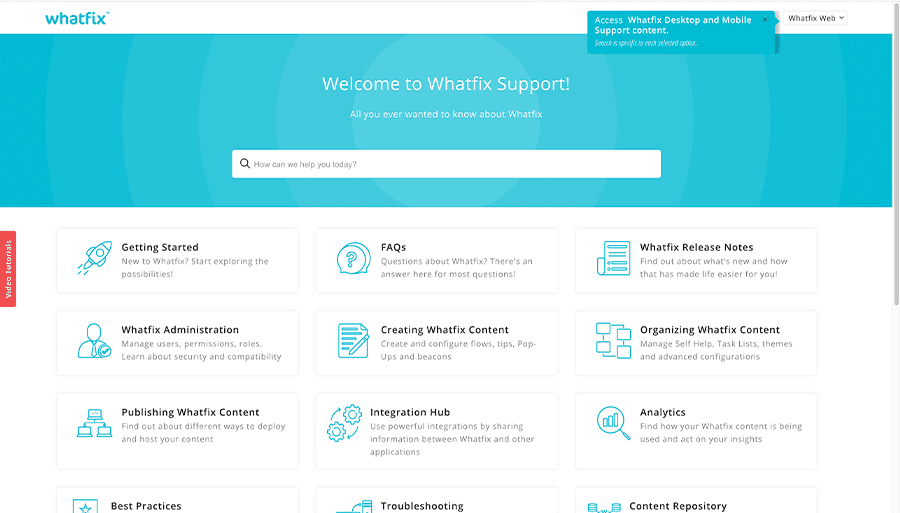
For another example, footwear and apparel company TOMS has an FAQ page that breaks down questions into categories. For instance, when you click on “returns,” you can see their return policy, find out how to get a refund, and return an item.
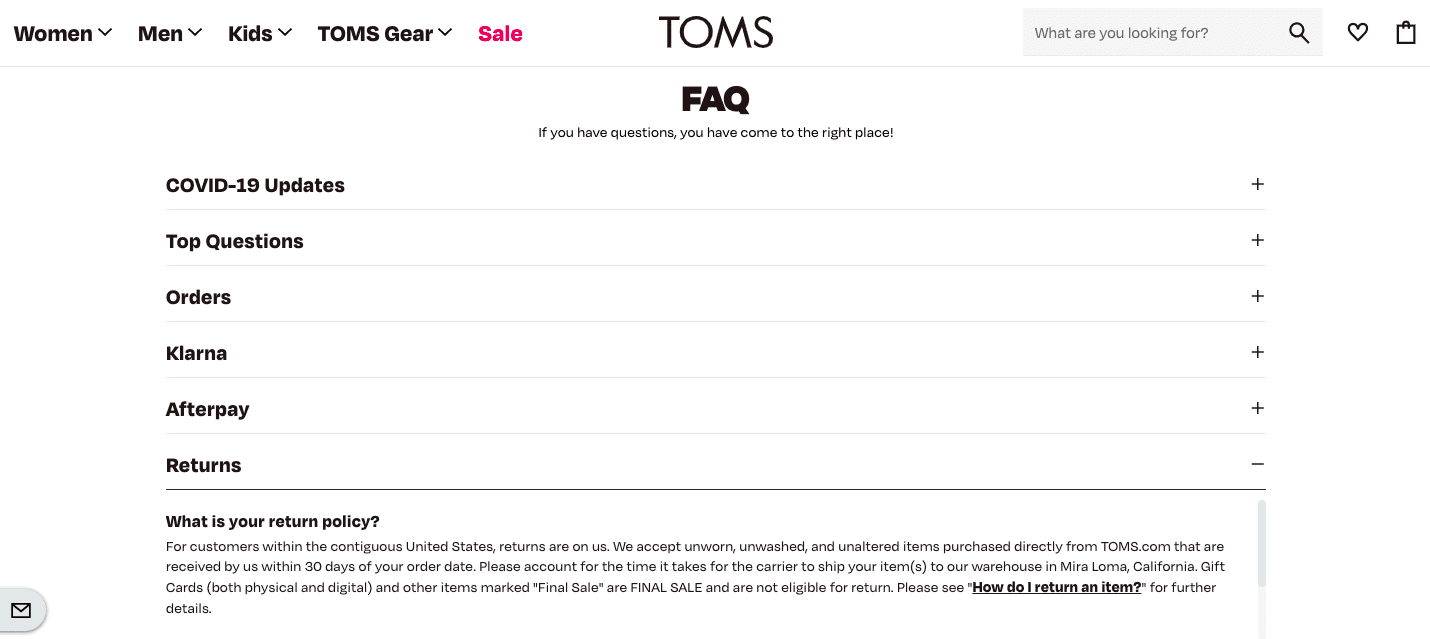
Collecting and organizing answers to common questions in this manner provides a streamlined experience for customers because they can easily zero in on the information they’re looking for without having to comb through your entire website.
6. Reward customer loyalty
Rewarding customers for their loyalty is a wonderful way to show your appreciation for them and can help prevent them from churning.
According to KPMG, 75% of consumers favor companies that offer rewards. Your customers want to feel celebrated and seen. You can do this by sending handwritten thank-you notes, providing free samples, offering a special discount, or having a loyalty rewards program.
Sephora’s Beauty Insider loyalty program boasts 25 million members, and these members are responsible for 80% of the company’s sales.

In addition to earning rewards for each purchase, members of the Beauty Insider program also receive an omnichannel experience:
- While using the Sephora mobile app in-store, customers get information to help them with their shopping, such as product recommendations, a view of similar items browsed by other shoppers, and access to their personal beauty profile.
- Store associates keep a record of products used or recommended during a consultation and send them to members for future reference, along with videos and before-and-after pictures.
Sephora provides a great example of a 2-for-1 approach to customer service: customers are rewarded for their loyalty and are offered an omnichannel experience that enhances their shopping journey.
7. Personalize the customer experience
Providing customers with experiences tailored to their individual needs and preferences helps your brand engage with customers more personally. This helps build trust and makes customers feel more valued, which inspires greater brand loyalty and strengthens customer relationships.
In fact, a Segment survey found that 44% of consumers will likely become repeat buyers after a personalized digital customer experience.
It doesn’t take much to go the extra mile for your customers. Small tokens of acknowledgment and gestures of appreciation — such as addressing customers by their name (and pronouncing it correctly), remembering their purchase history, or noting their preferences — can go a long way.
8. Equip your team with tools and software to help them work more efficiently
Empowering your support team with the right software and tools to succeed helps streamline their work and also gives customers more personalized and customized support.
For example, common customer support tools that empower teams to provide outstanding customer service include:
- CRM tools such as Salesforce, Zoho, or HubSpot to keep track of user information and customer interactions and history.
- Chatbots or customer communication tools, such as Intercom.
- On-demand self-help support tools such as Whatfix’s to provide guided walkthroughs and in-app wikis, as well as analytic tools to study user behavior and see where customers are hitting barriers or may need extra help navigating your product or service.
- Help desk software such as Zendesk to manage customer service across multiple online and offline channels.
- Social media management and monitoring tools such as Sprout Social to catch customer service issues and complaints on popular social networks.
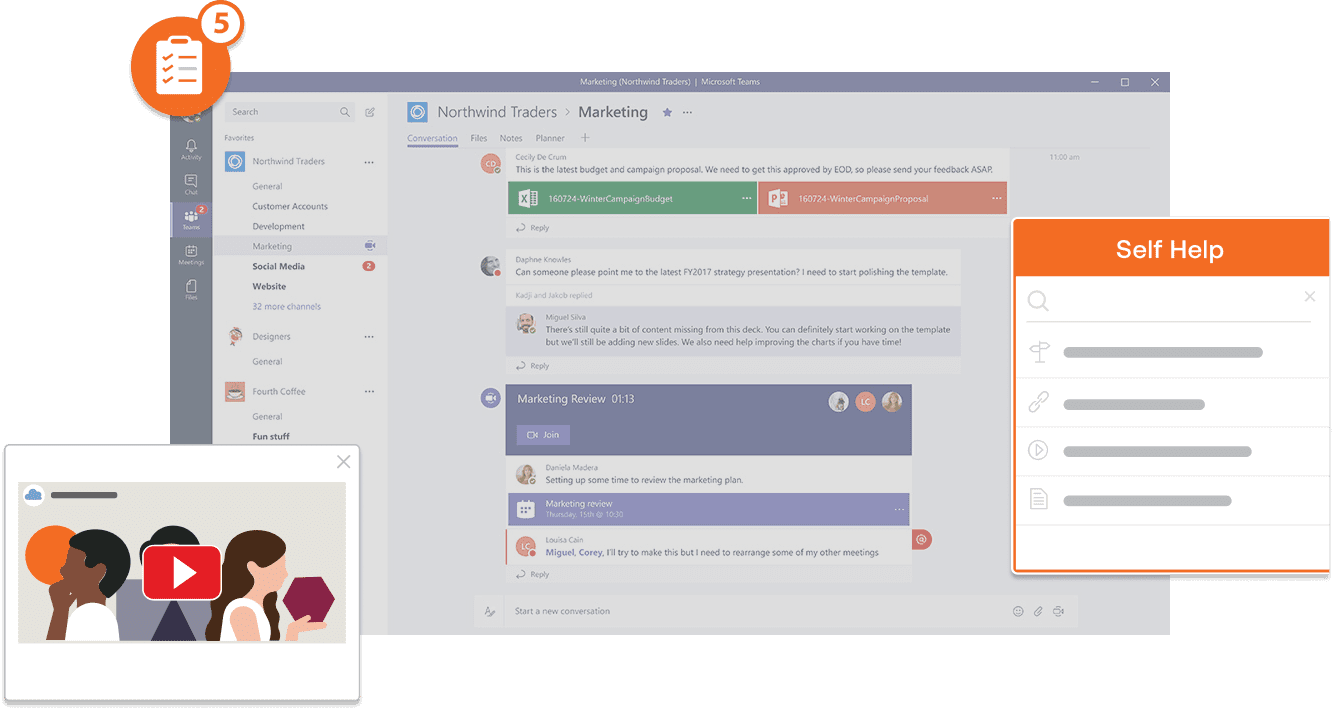

9. Be transparent with your customers
Being accountable and openly sharing information with your customers creates brand trust and good communication and helps build consumer loyalty. For example, transparency includes updates about delivery delays, product recalls, slow responses, and changes that may affect the price or quality of products and services.
In fact, more than 73% of consumers “consider transparency more important than price,” and nearly 40% say “they would switch from their preferred brand to one that offered more transparency.”
For example, whenever Netflix raises the prices on its subscription service, they send an email to customers explaining the reason behind the price hike: “Prices are being updated so that we can continue to offer more variety of TV shows and films.”

10. Use AI to automate tasks
From chatbots to call center scripts, AI can help automate simple and common customer service issues and requests, such as updating account information or canceling services.
AI also helps provide 24/7 and real-time customer support, reduces the number of support tickets issued, and frees up the time for customer service representatives to handle more complex issues. According to Salesforce, “64% of agents with AI chatbots are able to spend most of their time solving complex problems, versus 50% of agents without AI chatbots.”
Even when using AI technology, you can still ensure that customer service interactions aren’t robotic. For example, you can design and program chatbots to use language that is empathetic and engaging.
The direct-to-consumer mattress company Casper does this with its insomnobot-3000, a chatbot created just for insomniacs. The bot is programmed to sound like a real person, and simply by texting “insomnobot3000” from your mobile phone, you can have a conversation with it.
Over time, the bot learns your preferences and can converse with you on a wide range of topics ranging from your favorite hobbies to pet peeves.

Casper collects mobile numbers through the chatbot and sends promotional offers and discounts to its customers. And thanks to the insomnobot-3000, Casper raked in $100 million in sales during the first year of its launch.
Measuring Customer Service
Once you’ve put training and best practices in place to deliver excellent customer service, you need to measure how your team is performing. But how do you measure customer service?
Here are a few ideas and tactics for measuring customer service.
Customer surveys
One of the most straightforward ways to measure the effectiveness of your company’s customer services is through customer surveys.
Customer surveys are an effective way to gather valuable feedback from your customers. However, it can be challenging to get customers actually to fill them out. Some options for improving your response rates include – offering incentives like discounts or rewards points, having surveys pop-up at checkout or after a purchase, or in-app surveys.
Social media
Another great channel for measuring customer service is social media.
Your social media platforms allow you to communicate with customers in real time and understand how they feel directly after interacting with your brand. However, social media can be a bit of a double-edged sword as you can quickly destroy customer relationships by not promptly responding to customer communications there.
Mystery shoppers
A classic technique for measuring customer service is to use mystery shoppers.
Mystery shoppers are hired to test various areas of your business and your staff’s responses to common and unique customer situations. Employees are unaware these shoppers are not real customers, and you can get a better understanding of your customers’ interactions and experiences with your employees by using this method.
Company website
Lastly, you can leverage your company website to gather customer feedback and measure customer service levels.
Include an open contact form on your website to allow customers to leave valuable feedback on their experiences and interactions with your brand. You can further focus this feedback by including specific questions or filters for customers to give feedback exclusively on customer service topics.
In today’s business climate, where bad customer service seems to be the norm, your company can stand out by providing great service that transforms ordinary customer moments into special experiences. But that’s still not enough. Your company will need to continually upgrade its customer service experience to adapt to the times and evolve with your customers’ ever-changing needs.
With Whatfix, brands are empowered to create in-app guided content and on-demand self-help support to provide customers with contextual help, in the moment of need.
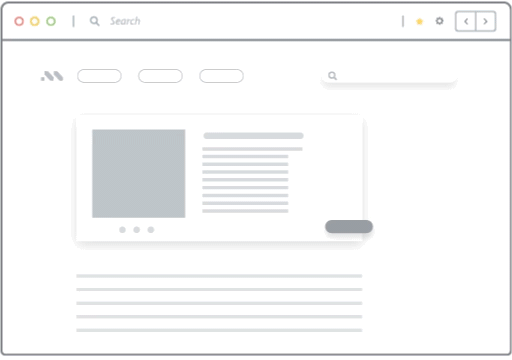

Learn how Whatfix provides customer service support through in-app messaging, guided walkthroughs, and self-help knowledge bases.
Request a demo to see how Whatfix empowers organizations to improve end-user adoption and provide on-demand customer support.
Thank you for subscribing!


